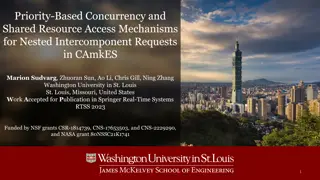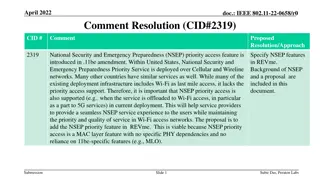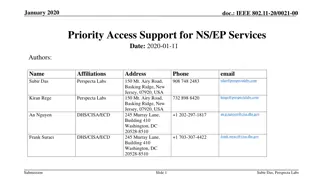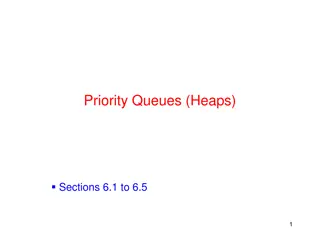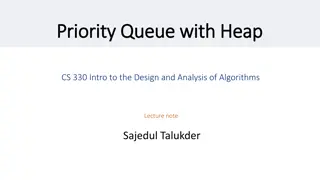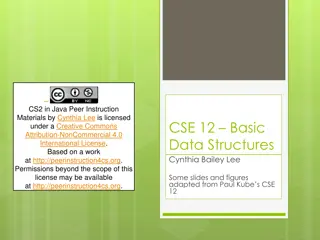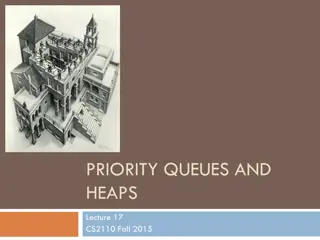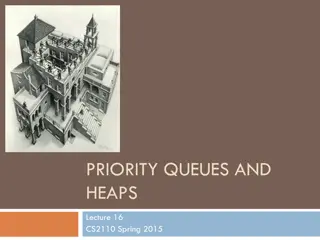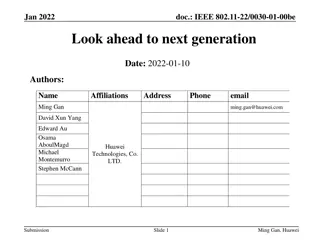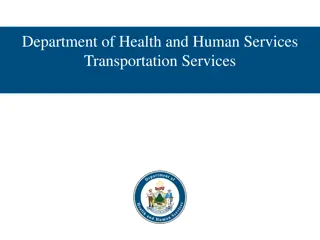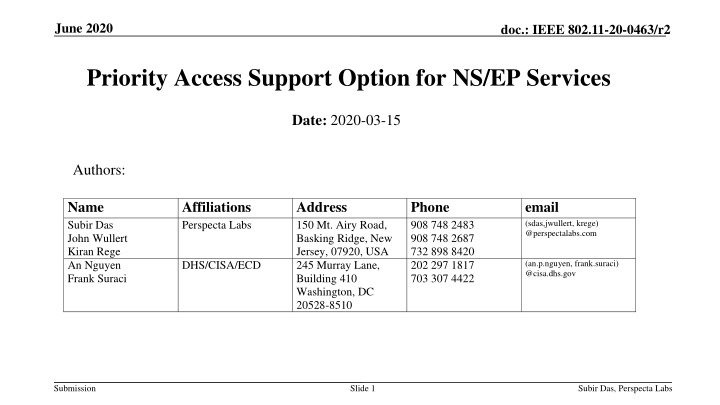
Priority Access Support for NS/EP Services in IEEE 802.11be Standard
Enhance your understanding of the priority access support for National Security and Emergency Preparedness (NS/EP) services as proposed in the IEEE 802.11be standard. This presentation outlines the objectives, existing NS/EP priority services, and the need for a standardized mechanism to ensure priority access during network congestion, benefiting various critical applications beyond NS/EP services.
Download Presentation

Please find below an Image/Link to download the presentation.
The content on the website is provided AS IS for your information and personal use only. It may not be sold, licensed, or shared on other websites without obtaining consent from the author. If you encounter any issues during the download, it is possible that the publisher has removed the file from their server.
You are allowed to download the files provided on this website for personal or commercial use, subject to the condition that they are used lawfully. All files are the property of their respective owners.
The content on the website is provided AS IS for your information and personal use only. It may not be sold, licensed, or shared on other websites without obtaining consent from the author.
E N D
Presentation Transcript
June 2020 doc.: IEEE 802.11-20-0463/r2 Priority Access Support Option for NS/EP Services Date: 2020-03-15 Authors: Name Subir Das John Wullert Kiran Rege An Nguyen Frank Suraci Affiliations Perspecta Labs Address 150 Mt. Airy Road, Basking Ridge, New Jersey, 07920, USA 245 Murray Lane, Building 410 Washington, DC 20528-8510 Phone 908 748 2483 908 748 2687 732 898 8420 202 297 1817 703 307 4422 email (sdas,jwullert, krege) @perspectalabs.com DHS/CISA/ECD (an.p.nguyen, frank.suraci) @cisa.dhs.gov Submission Slide 1 Subir Das, Perspecta Labs
June 2020 doc.: IEEE 802.11-20-0463/r2 Outline This presentation covers the following: Overview of NS/EP Priority Services Assumptions An approach for indicating the priority access need for NS/EP Priority Service non-AP STA(s) to AP STA using OFDMA-based Triggered Uplink Access framework Submission Slide 2 Subir Das, Perspecta Labs
June 2020 doc.: IEEE 802.11-20-0463/r2 Overview Priority access support for National Security and Emergency Preparedness (NS/EP) priority services was approved as a work item in IEEE 802.11be during January 2020 meeting [1] Objective Summary A standardized mechanism to support the NS/EP priority services in WLANs without requiring additional infrastructure Priority Access in IEEE 802.11be would also be beneficial to other services ( e.g., Public- Safety Mission-Critical Services, Critical medical applications) Submission Slide 3 Subir Das, Perspecta Labs
June 2020 doc.: IEEE 802.11-20-0463/r2 NS/EP Priority Services Service Objective: Provide priority access to system resources for a limited set of authorized users during network congestion Priority Access: Allow preferred access to the wireless medium during network congestion and/or failures to establish a data session Limited Set: Number of users is generally a small fraction of the overall user base Authorized Users: Only available to some designated individuals who are identified to receive such service Existing NS/EP Priority Services in the US provide priority voice calls over public networks Government Emergency Telecommunications Service (GETS): Landline phone networks Wireless Priority Service (WPS): Wireless phone networks Next Generation Network Priority Services (NGN-PS): Providers IP-based communications networks Many countries have similar priority telecommunications services, e.g., Belgium: Blue Light Mobile, Canada: WPS, Czech Republic: Mobile Crisis Communications service, Great Britain: MTPAS GSM for Railway Communications deployed in multiple countries NS/EP Priority Services are NOT Emergency Services (e.g., E911 in US; 112, 999, etc. in Europe) Submission Slide 4 Subir Das, Perspecta Labs
June 2020 doc.: IEEE 802.11-20-0463/r2 Assumptions NS/EP Priority Service user s non-AP STA is associated with BSS prior to invocation of priority capabilities Authentication/Association and authorization occur via standard procedures After association, AP STA has the knowledge of which non-AP STAs are authorized to use NS/EP priority services NS/EP Priority Service non-AP STA will inform the AP STA regarding the need for Priority Service Mechanism for communicating the need for priority access to the AP STA is the focus of this presentation. The method of identifying the need for priority access is out of the scope of TGbe The priority remains in effect until terminated by either party NS/EP Priority Service non-AP STA supports UL MU-MIMO operation Submission Slide 5 Subir Das, Perspecta Labs
June 2020 doc.: IEEE 802.11-20-0463/r2 Realizing NS/EP Priority Service Concept NS/EP non-AP STA associates with AP STA Managed AP/AP Controller retrieves user s NS/EP priority attributes (e.g., user priority level, credentials, etc.) during association Managed AP/AP Controller verifies authorization to use NS/EP priority service via access/service provider Managed AP/AP Controller caches the non-AP STA s NS/EP priority service profile Non-AP STA user indicates* priority for a NS/EP session on-demand (e.g., when experiencing poor network performance) by signaling the need for priority access Mechanism for determining the need for invoking this service is out of scope Goal of NS/EP priority is to support existing access-category QoS even under congestion (e.g., serve NS/EP non-AP STAs first) Non-AP STA user deactivates NS/EP priority service when priority is no longer needed e.g., session is over, network conditions return to normal * Note: This is low-frequency event due to limited use for NS/EP purposes (Ref[1]) Submission Slide 6 Subir Das, Perspecta Labs
June 2020 doc.: IEEE 802.11-20-0463/r2 Network Architecture (Simplified) Wi-Fi Access Provider Core Network AP Regular STA Access Controller/ Gateway AAA NS/EP Authorized STA AP STA- Wi-Fi Device AP- Wi-Fi Access Point The service provider and/or the access provider are(is) responsible for identifying, authenticating and authorizing a NS/EP STA for priority access The capabilities are exchanged during authentication/association The additional element in CapabilityIE is TBD Submission Slide 7 Subir Das, Perspecta Labs
June 2020 doc.: IEEE 802.11-20-0463/r2 Proposed Approach Use existing BSRP Trigger Frame and extend QoS Control Field format to indicate the NS/EP Priority Service non-AP STA s Priority Access need in buffer status report Submission Slide 8 Subir Das, Perspecta Labs
June 2020 doc.: IEEE 802.11-20-0463/r2 Use of OFDMA .11ax Triggered Uplink Access for NS/EP Priority Services Enabling priority in OFDMA scheduling (in presence of network congestion) AP STA polls non-AP STAs using BSRP Trigger Frame to determine data to be sent upstream Subsequent messages may not require a Trigger Frame NS/EP Priority Service non-AP STA reports access class and buffer status with priority indication Proposed enhancement enables STA to provide priority indication AP STA verifies authorization for NS/EP Priority Service AP STA incorporates priority into scheduling and RU-allocation decisions for NS/EP Priority Service non-AP STA Submission Slide 9 Subir Das, Perspecta Labs
June 2020 doc.: IEEE 802.11-20-0463/r2 QoS Control Field Format for IEEE 802.11ax QoS Control Field Format A-MSDU Present TID 1 Ack Policy Queue Size QoS Control field QoS Control field enables non-APSTA to report the buffer status after receiving the Trigger Frame (e.g., BSRP) poll from an AP STA Non-AP STA can send multiple QoS Control fields to indicate requirements for multiple TCs Non-AP STA sends QoS Control field with TID and Queue Size in QoS Data or QoS Null frame TID (4 bits) maps to User Priority (UP) value UP Values 0-7 are assigned Values from 8 to 15 are not used in buffer status report in .11ax Submission Slide 10 Subir Das, Perspecta Labs
June 2020 doc.: IEEE 802.11-20-0463/r2 Proposed Approach: Use QoS Control Field QoS Control field Format bits 8-15 bits 5-6 bits 0-3 bit 7 bit 4 A-MSDU Present 1 Ack Policy Queue Size TID=1101 (Priority Service Indicator ) Encode priority in QoS Control field TID Rationale: Only values 0-7 (3 bits) are used to indicate UP (mapped to AC) Proposal: Use one value >7 of 4-bit TID to indicate the need for NS/EP Priority Services Use TID= 1101 (13) to indicate that the Priority Service is required NS/EP Priority Service non-AP STA sets TID=1101 in QoS control field while sending the buffer status report in response to a BSRP trigger poll frame. In case non-NS/EP Priority Service STAs set TID= 1101 in buffer status report, AP will be able to deny the Priority Access based on the authorization information. If one QoS Data or Null frame within an A-MSDU has as TID of 1101, all other queues are treated as priority. Impact: Legacy STAs will not be able to decode this information but this should not be an issue since MIB can be updated to address the backward compatibility. Submission Slide 11 Subir Das, Perspecta Labs
June 2020 doc.: IEEE 802.11-20-0463/r2 NS/EP Priority Access Procedures Frame Carrying Trigger with RUs allocated to NS/EP STA NS/EP STA Capability Information Frame carrying BSRP Trigger Ack Ack AP Frame carrying BSR in QoS data and/or null frame with TID value set to 1101 Capability exchanged during Association EHT TB PPDU with UL Data NS/EP STA (EHT) Time = t AP polls the STAs using BSRP Trigger Frame to determine data to be sent upstream. At time t , the NS/EP STA determines the need for priority and sets the TID value to 1101 of QoS control field while sending the subsequent buffer status report in response to a BSRP trigger frame as an indication to the AP (with which it is associated) that the Priority Access is required After receiving the Priority Access indication, AP verifies the STA s authorization information (AP has this knowledge during authentication/association) Submission Slide 12 Subir Das, Perspecta Labs
June 2020 doc.: IEEE 802.11-20-0463/r2 NS/EP Priority Access Procedures Contd.. If the STA is authorized to obtain the service, AP prioritizes the RU allocation to the NS/EP STAs for UL/DL transmissions similar to .11ax procedures. RUs can be assigned to one or more NS/EP STAs based on buffer status The NS/EP STAs access these resources (slots) to gain the prioritized access As long as the STA identifies the need for priority, it continues to include a QoS control field with the TID value set to 1101 in QoS data and/or null frames. If it determines that the priority treatment is no longer needed, it stops including this TID value in the QoS control field Submission Slide 13 Subir Das, Perspecta Labs
June 2020 doc.: IEEE 802.11-20-0463/r2 Additional Clarifications BSR containing QoS frame with TID > 7 is proposed to signal that NS/EP non-AP STA requires Priority Access (i.e., to turn the service on) Presence of such frame indicates that data in NS/EP STA buffers should receive priority over other non-AP STAs Absence of such frame indicates that data in NS/EP STA buffers should receive same treatment as other non-AP STAs A single TID value signals the need for Priority Access In particular, it is not mapped to any specific access class Mapping of the TID value to an access class at the AP STA is an implementation issue Other QoS data frames reported in BSR use existing TIDs (<7) to indicate the AC NS/EP Priority Service is not a low latency service Specific TID value > 7 is TBD Value of 13 is proposed since it is the next highest unused value available May be possible to reuse TID=15 (currently used in .11ax m-BA) by defining appropriate procedures Submission Slide 14 Subir Das, Perspecta Labs
June 2020 doc.: IEEE 802.11-20-0463/r2 Summary Described a simple approach by which NS/EP Priority Service non-AP STAs can signal the AP STA that priority access is required during network congestion Leverages existing BSRP Trigger Frame Use of one TID value in buffer status report No other existing mechanisms need to be modified Backward compatible Feedback and comments ?? Submission Slide 15 Subir Das, Perspecta Labs
June 2020 doc.: IEEE 802.11-20-0463/r2 Straw Poll 1 Do you support the addition of following text to TGbe SFD? The NS/EP Priority Service if supported by a non-AP STA, shall use a TID value >7 to indicate the need for priority access to AP STA Note: The identification of the need is outside the scope of this specification. Note: The container of the TID is TBD. Y: N: A: Submission Slide 16 Subir Das, Perspecta Labs
June 2020 doc.: IEEE 802.11-20-0463/r2 References [1] 11-19-1901-04-00be-priority-access-support-in-ieee-802-11be-what-and-why.pptx [2] 11-20-0021-01-00be-Priority-Access-support_for_NS_EP_Services.pptx, [2] IEEE P802.11ax /D6.0, Part 11: Wireless LAN Medium Access Control (MAC) and Physical Layer (PHY) Specifications, Amendment 1: Enhancements for High Efficiency WLAN , November 2019 [3] IEEE Std 802.11 -2016, Part 11: Wireless LAN Medium Access Control (MAC) and Physical Layer (PHY) Specifications , 7 December 2016 Submission Slide 17 Subir Das, Perspecta Labs

